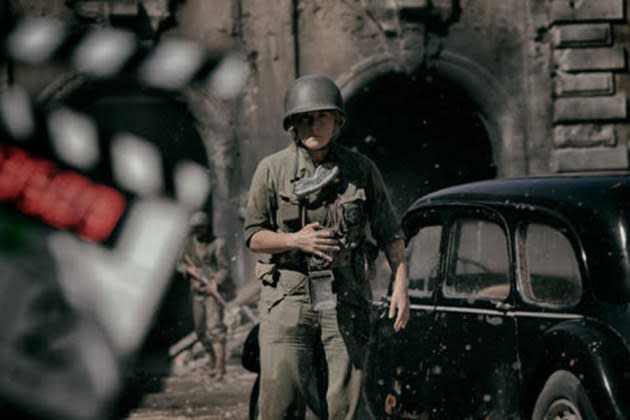‘Lee’ Review: Kate Winslet Deploys Impressive Range as a War Photographer in a Standard Biopic
- Oops!Something went wrong.Please try again later.
- Oops!Something went wrong.Please try again later.
- Oops!Something went wrong.Please try again later.
- Oops!Something went wrong.Please try again later.

From the moment Elizabeth “Lee” Miller (Kate Winslet), an American model turned photographer, meets future husband Roland Penrose (Alexander Skarsgård) at a gathering with her intellectual friends, she gets confrontational. In a matter of a few sentences, Lee dismantles his efforts to be perceived as less bourgeoise than he is. Roland retaliates with a matching appraisal of her fierce facade. But instead of souring their interest in one another, the polite bickering ignites a long-lasting romance.
That early scene in the mostly conventional biopic “Lee,” from cinematographer-turned-director Ellen Kuras, establishes Lee’s abrasively magnetic personality, and offers a ferocious first glance at the imposing dramatic range Winslet summons to portray her.
More from Variety
Based on Antony Penrose’s book “The Lives of Lee Miller,” Kuras’ film uses an interview with a young writer (Josh O’Connor) as its conspicuous framing device. “What do I get in return?” asks an elderly Lee of the man interrogating her chaotically remarkable existence. As she begrudgingly retells her misadventures across Europe, stumbling into one history-defining instance after another with her camera, the interviewer turns visibly moved. Alexandre Desplat’s score does its part in helping build an atmosphere both poignant and propulsive (particularly on the battlefield) to hold as much of who Lee was as possible.
Near the end of World War II, Lee lands a job at British Vogue. At first, her keen eye for capturing her subjects’ essence finds purpose in portraits of the women partaking in the war effort at home. Yet, her interest lies in the front lines, where women are not allowed. Unwilling to back down from that goal, she manages to travel with American troops to document the armed conflict with her camera. Crafting impeccable, if not particularly striking images, cinematographer Pawel Edelman (“The Pianist”) lends “Lee” the kind of glossy grittiness expected from prestige Hollywood pictures set in this time period. There’s a standardly pristine quality even in scenes that happen amid the destruction.
That Lee was on the ground to take photos of the liberation of France and later of the abhorrent, unthinkable horrors of the Holocaust — including images of piles of emaciated bodies from Nazi concentration camps at a time when the magnitude of the atrocities was unknown — speaks of her reckless bravado, which Winslet embodies. Her most notorious work, however, was staging a morbid photo of herself inside Hitler’s private bathtub.
The major names who comprise the star-studded ensemble appear mostly in bit parts. French stars Marion Cotillard and Noémie Merlant each get a brief notable onscreen moment as Lee’s friends hiding in Paris. Andrea Riseborough as supportive Vogue editor Audrey Withers brings necessary warmth, while an astutely cast Andy Samberg (the most substantial of the supporting players) takes on Lee’s colleague, Time photographer David E. Scherman, in his most dramatically earnest role to date.
Though proficiently realized and expectedly solemn, “Lee” lacks any formal impetus that can mimic the fury behind the eyes of its heroine. What Winslet, also a producer, brings to the screen (a believably complicated cocktail of defiance, fear and despair) feels too honest and emotionally raw for this mannered cinematic portrait of a singular life. Still, it’s partly because of how by-the-numbers the project is that her fantastic interpretation of a woman unconcerned with upholding the status quo stands out so intensely. Even at her character’s most vulnerable, the Oscar-winning actor presents Lee with an edge of defensiveness, her guard never fully down, likely tied to a traumatic event in childhood.
Throughout their subject’s fearless travels, screenwriters Liz Hannah, Marion Hume and John Collee confront Lee with situations that illustrate the issues that afflicted women during the war. And while these scenes try to reinforce her relevance today, as a collection of events, they ultimately come off as more schematic than organic. Given its scope and its supplementary narrative threads (such as Lee’ relationship with her son, or her feelings on her husband’s passive involvement in the war devising camouflage techniques), “Lee” is also unfocused in what it wants to bring to the foreground about her.
Late in “Lee,” there’s a cathartic moment for the protagonist, as she reacts impulsively to the possibility that the public won’t be able to bear witness on the page to what she saw in the flesh. That’s not only the film’s most assured statement for the historical significance of Lee’s work, but also another chance for Winslet to demonstrate why this rageful portrayal is among her very best transformations.
Best of Variety
Sign up for Variety’s Newsletter. For the latest news, follow us on Facebook, Twitter, and Instagram.
